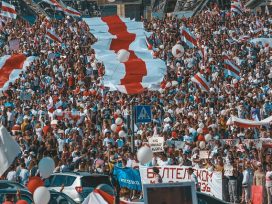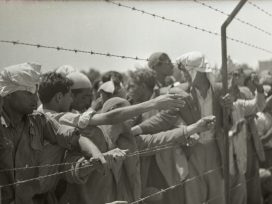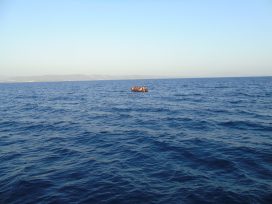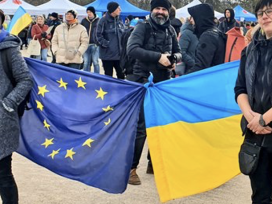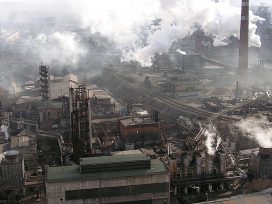Multiple institutions – not just the European Cultural Foundation – are currently asking us Europeans to tell them our European stories. The Council of Europe, for example, is organizing a series of workshops to develop new narratives for discussing themes like the industrial revolution in schoolbooks from a European, not national perspective. And the House of European History due to open in Brussels in 2014 is devising interactive methods for collecting stories from its visitors.
These and other initiatives more or less explicitly seek a degree of convergence and consensus in the way we remember, individually and collectively, our past and debate our future. Clearly, collecting European narratives is not an innocent cultural practice. Rather, it is a highly politicized normative practice to bolster – in this case – a particular “European” position in what the sociologist Claus Leggewie has recently called the European “battlefield of memory”.
The search for European narratives appears to be motivated by two contemporary experiences. First, globalization has created many opportunities, but also socio-economic losers who are harking back to an apparently better past. In an attempt to capitalize on the desire to feel emotionally secure through the collective memory of such a better past, populist rightwing political parties in particular propagate the resurrection of national master-narratives. This is reflected in the Dutch debate about a narrative canon of key events in national history or in the British debate about re-centring history teaching in schools on British history, for example. More transnationally connected and socialized elites have rightly criticized the romantic notions of the nation underlying these proposals, which are effectively defined in opposition to others. However, they have to offer other, more inclusive ways of remembering the past without sinking new historical narratives in a sea of globalization and global history. “Europe” appears to have the potential to serve as a sufficiently inclusive intermediate site for developing such new narratives that could still provide a degree of historical and cultural orientation in fast changing times.
At the same time, the search for European narratives is often also motivated by the desire to strengthen the legitimacy of the European Union (EU). The early European integration process was still characterized by a strong consensus. The citizens of the EU largely agreed that integration was a good thing, but they were not interested in its supranational politics. Since the debate about the Maastricht Treaty in the early 1990s, however, European integration has become much more contested. The quality of the EU’s policies no longer appears sufficient as a source of its popular legitimacy. At the same time, democratic participation in EU politics cannot compensate for this reduced “output” legitimacy, as “Brussels” seems too remote as a site for political action. Apparently, the EU as a polity is also in need of new narratives that can anchor it more than hitherto in a shared understanding of Europe’s history and culture – even if this shared history and culture (as Benedict Anderson has put it) may be just as “imagined” as beliefs in the cohesion of national history and culture in the nineteenth century.
At that time, historians played a key role in devising master-narratives as hegemonic ways of telling stories about the past, to form new nations and to foster state-building. In the words of the British historian Eric Hobsbawm, these historians were “to nationalism what poppy-growers in Pakistan are to heroin-addicts”, supplying “the essential raw material for the market”. More recently, however, historians have been inclined to deconstruct such national master-narratives. They advocate – with Konrad Jarausch – “narrative pluralism” and “narrative tolerance” towards different ways of remembering the past and even the same events. As these historians refuse to provide authoritative narratives of the past, they are naturally reluctant to devise blueprints for new European master-narratives. Their reluctance is strengthened further by the all pervasive criticism of allegedly “Euro-centric” narratives of world history – a habitual view in post-colonial studies of all kinds, which appears to exclude any narrative that emphasizes differences between Europe and other parts of the world, let alone the possible superiority, from a normative perspective, of our prevailing cultural traditions, societal organization or institutional order.
Like these historians, many cultural institutions like museums now only define the extreme limits of their own narrative tolerance, excluding, for example, memory that denies the Holocaust. Within these limits, however, they often consider and present any story as just as valid as any other story of the past, apparently refusing to take sides in conflicting accounts of the past. This trend has fed the rapid growth of what might be dubbed the eye-witness industry in museums which started with the Holocaust memorials and museums.
Social psychologists and historians using oral history methods have shown that, many decades after the events, people have a very blurred vision of the past. People integrate knowledge acquired and stories heard since these events into how they recollect them. It is crucially important to human beings to make their recollections appear coherent and compatible with their contemporary life circumstances and normative preferences. Thus, such testimonies tell us much about the eye-witnesses, but very little about the past.
“Narrative tolerance” in cultural institutions creates two fundamental and interlinked issues which most museum curators conveniently ignore. First, the vast majority of visitors still expect the museum to provide them with a reasonably cohesive and intelligible narrative of what happened when. Eye-witnesses are therefore bound to be taken at face value, as if they were replacing curators in telling historical truths. Second, since the curators induce, select, and present sections of eye-witness accounts using particular representational forms, the eye-witness is in fact another medium for propagating certain narratives. In other words, narrative tolerance in cultural institutions (as in books by historians) may in many cases amount to little more than a cleverly disguised form of exercising narrative authority.
One excellent example of such an attempted exercise of narrative authority drawing upon eye-witness accounts is the exhibition “C’est notre histoire!”, which was on show in Brussels in 2007-8 and in Wroclaw in 2009. In order to advance an enthusiastically positive and optimistic narrative of postwar European integration and the present-day EU and its future, the curators put 27 eye-witnesses at the core of their exhibition – one per member-state. At the entrance to the exhibition they actually claimed that they could have chosen any other EU citizen in order to tell the same story about lived European integration. The 27 stories allegedly stood for how Europeans have experienced a shared past.
 The exhibition company Tempora claimed that the combination of testimonies for “C’est notre histoire!” was not guided by any particular rationale. However, most of the 27 testimonies appear to have been neatly selected and arranged so as to cover most of the EU’s major objectives and policies. Thus, the Polish eyewitness argues that “when life is good for people, they don’t want to fight wars”, highlighting the EU’s contribution to increasing the welfare of its citizens. The military officer from Luxembourg emphasizes that “we all know that the priority of the EU isn’t in the military sphere but rather development aid or diplomacy”, thus reiterating the EU’s self-image as a normative power. The Swedish employee of the multilateral European Organization for Nuclear Research centre in Geneva claims that scientific collaboration is “all about the common European knowledge capital” to enhance the EU’s competitiveness. In this latter case, the language used in the interview actually replicates one-to-one European Commission policy papers and rhetoric. In a similar vein, the European Parliament (EP) Visitors’ Centre due to open in the autumn of 2011 also uses 27 eye-witnesses to explain the advantages of EU legislation and the beneficial role of the Parliament in bringing them about.
The exhibition company Tempora claimed that the combination of testimonies for “C’est notre histoire!” was not guided by any particular rationale. However, most of the 27 testimonies appear to have been neatly selected and arranged so as to cover most of the EU’s major objectives and policies. Thus, the Polish eyewitness argues that “when life is good for people, they don’t want to fight wars”, highlighting the EU’s contribution to increasing the welfare of its citizens. The military officer from Luxembourg emphasizes that “we all know that the priority of the EU isn’t in the military sphere but rather development aid or diplomacy”, thus reiterating the EU’s self-image as a normative power. The Swedish employee of the multilateral European Organization for Nuclear Research centre in Geneva claims that scientific collaboration is “all about the common European knowledge capital” to enhance the EU’s competitiveness. In this latter case, the language used in the interview actually replicates one-to-one European Commission policy papers and rhetoric. In a similar vein, the European Parliament (EP) Visitors’ Centre due to open in the autumn of 2011 also uses 27 eye-witnesses to explain the advantages of EU legislation and the beneficial role of the Parliament in bringing them about.
This particular approach to utilizing eye-witnesses for telling stories about the past involves the strategic identification of the overall narrative message and the posing of pre-formulated questions designed to provoke targeted replies. For example, a Spanish truck driver comments that EU health and safety regulations guarantee that he gets enough sleep when on the road; the selection of passages of his personal story fit the narrative message, which is conveyed via an appropriate technical and representational strategy. However this approach to narrating Europe raises two fundamental issues. The first concerns the obvious strategic manipulation of the resulting narrative message about Europe’s contemporary history and the future of the EU. Can such a narrative strategy possibly be credible in the eyes of the beholder, or visitor, especially when he or she finds it in a cultural institution funded by an EU institution, such as the EP Visitors’ Centre or the House of European History? The answer to this question is, emphatically, no. Visitors sense that European integration has been hotly contested and they know how controversial many issues are in the present-day EU. If the narrative message glosses over such frictions and controversies, it can only contribute to the alienation of citizens from the EU.
This kind of glossy narrative message is not only ineffective, it is also undesirable; at least, if cultural institutions like museums really wish to serve, as they should do, as an important arena for debate about our partly shared past and our common future in the emerging transnational society of Europe and the multi-level polity of the EU. Indeed, from this perspective, the primary purpose of museums should be to highlight how our understanding of the past still differs (not just across national divides) and how our preferences for the future diverge. This assists a more strongly transnational deliberation about, and negotiation of, our narratives of the past and our views of the future. It is not the outcome of such a deliberation and negotiation that matters, but the process of engaging European citizens in it.
How, then, to induce, collect and represent narratives of Europe? The first option for cultural institutions is to engage citizens in what we might call participative narrating – that is, to motivate them (without following a particular normative agenda) to tell their own stories. Stories collected in this way will be narratives of transnational encounters and experiences that will normally have taken place in a predominately European geographical and social space. Such individual narratives may concern the first holiday outside one’s own country, working as an au-pair with another family abroad, falling in love with another European national, working with other Europeans in devising a business plan, for example. They may be predominantly positive or negative experiences, including, for the older generation in particular, hurtful memories of occupation, oppression, and racism.
Sociologists have for a long time been so preoccupied with studying national societies and welfare states in comparison that they have only recently begun to focus on the increasing transnationalization of social life in Europe and beyond. At the same time, historians utilizing oral history methods have focused so much on the local rather than the transnational, European or global, that they have failed to collect narratives of transnational experiences in Europe. If cultural institutions became more active in pooling such individual narratives, it would therefore benefit research on this form of transnational social integration.
This form of participative narrating has the potential to strengthen our collective memory of transnational and intercultural encounters in Europe. In this way, it may well enhance what sociologists call our civilizational identity as Europeans. Some of these transnational experiences may have been facilitated by legislation and the policies of the present-day EU, concerning for example the freedom of movement of people and goods, or by bilateral treaties among its member-states such as the Franco-German treaty of 1963, which created a framework for cultural and youth exchange. But non-strategic, participative narration as opposed to the methods used by the curators of the exhibition “C’est notre histoire!” is unlikely to be able to emphasize the political context of European integration. It is, therefore, unlikely that this narrative approach to European history can strengthen our identity as EU citizens.
Narratives of European history designed to strengthen our collective political identity would have to go beyond the participative narration of individual transnational experiences, especially since transnational experiences can extend beyond the European geographical and social space. To this end, “memory entrepreneurs” have proposed a variety of negative narratives of the European twentieth century. They always include the Holocaust as a the key reference point. But, as Timothy Garton Ash has lucidly observed, not all Europeans may be keen to accept an equal share in the responsibility for the extermination of European Jews by Germans (and by others) during the Nazi rule over large parts of Europe. Moreover, narratives of the Holocaust can only remind us of basic norms of decent human behaviour and minimum standards of the rule of law, for example. While repeated reminders are no doubt important for societies, these norms and standards are just as relevant to any other country or region in the world, especially those that have experienced genocides of one kind or another, be it North America, Turkey, Cambodia or Rwanda. Memory of the Holocaust definitely cannot therefore be a source of legitimacy for the EU and its economic structure, political institutions or policies – quite apart from the fact that the Holocaust never was a factor in the creation of the EU in the first place.
Participative narrating of individual transnational experiences needs, then, to be complemented by a debate about what makes us European. Such a debate could produce narratives of our shared contemporary history which reflect our collective critical understanding of our past and its manifold dark sides (including, but not solely, the Holocaust); narratives, moreover, which are characterized by a shared awareness of our internal diversity and fragmentation, not just along national lines. Such a discursive construction of European narratives would set them apart from the nineteenth century foundation myths and master-narratives. However, such narratives cannot merely cultivate the memory of negative reference points and over-emphasize internal difference. Collectively, we need to overcome our post-colonial inhibitions to define more clearly what makes us, as Europeans, different from other parts of the world.
EU institutions have developed and propagated all kinds of smaller and larger myths. These are mostly linked to clearly delineated policy areas, such as the idea of the “green” Europe as an environmental leader. These narratives often serve particular institutional interests. Instead, we should debate narratives about larger questions about our political and societal organisation in contemporary historical perspective. The EU would feature as one key dimension of this. One of these narratives should evolve around the democratic constitution of Europe and its entities, which has always been contested and remains fragile. Crucially, this is not, and must not be told as, the story from Aristotle to Barroso. It would have to address the deficiencies and weakness of European democracy past and present, as much as its fundamental strengths, such as the recognition and protection of human rights and the transnational institutionalized negotiation of ideas and interests in the EU today. Nevertheless, such a narrative would remind us of core values that unite us; it would also enable us to propagate these norms and institutional solutions more confidently than the post-colonial value-neutral recognition of cultural difference might tolerate, which only induces contempt for an apparently soulless European society.
A second narrative could evolve around our understanding of the relationship between individual rights and enterprise and social solidarity and cohesion. Within Europe, various social welfare systems have dealt with this challenge in different ways. However, we have been largely united by the search, which has only sometimes been explicit in the prevailing political rhetoric, for a third way between a free-market system and a planned economy. This search is also linked to contested issues of European integration and EU politics, such as agricultural subsidies as a European social policy or fiscal redistribution through the EU’s regional and structural policies. But despite different traditions and preferences, Europeans nevertheless share similar ideas and have joint policies on social and welfare issues when compared to the United States or China, for example. Crucially, it is only this external comparison with other parts of the world, which the Holocaust “DIN norm” and post-colonial self-flagellation has prevented for a long time, that can help us develop reflexive narratives of our own relative unity.
Cultural institutions like museums can tell such stories in different ways. They may use the narrative of the so-called founding fathers, for example – the politicians who played a key role in the origins of western European integration after 1945. But let us not proceed to the sacralisation of their political deeds. After all, Robert Schuman voted for Marshall Pétain in 1940 and Konrad Adenauer toyed with the idea of allowing Franco’s Spain to accede to the European Economic Community – behaviour and preferences that museums should discuss critically and not keep silent about, let alone condone in order to create a new European mythology utilizing the same methods as nineteenth century nationalists.
Instead, such narratives should highlight how these politicians engaged in negotiating their different views on joint challenges such as the future of democracy in the Cold War, or of social cohesion in the reconstruction of post-war Europe, and how in the end they arrived at common decisions and sometimes, even, shared positions. They did so in the highly institutionalized political framework of the present-day EU, a fact that greatly facilitates the recording of transnational experiences in participative narrating processes. Moreover, despite legitimate criticism, Europe’s political institutions actually contribute a great deal to making our continent such a wonderful place to live.
